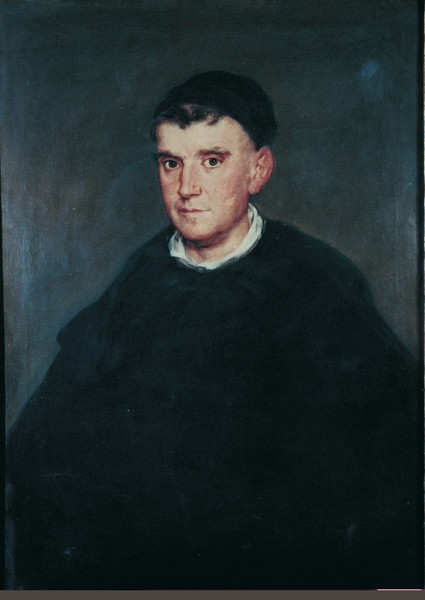- Cronología
- Ca. 1815 - 1816
- Ubicación
- The Royal Academy of History, Madrid, Spain
- Dimensiones
- 75 x 54 cm
- Técnica y soporte
- Oil on canvas
- Reconocimiento de la autoría de Goya
- Documented work
- Titular
- Royal Academy of History
- Ficha: realización/revisión
- 31 Dec 1969 / 16 Jun 2023
- Inventario
- (77)
The details of the commissioning of this portrait are not known, and neither is its exact chronology, with the work being dated according to the painting technique. However, we do have the evidence left by the sitter's niece, Carmen Arteaga Fernández de Reboto, as published in the book by María Rosario Barabino. The sitter's relative speaks of the close relationship between her uncle and the painter, forged by the numerous artistic discussions that the two men had, the artist being aware of the other man's profound knowledge of art. The high esteem in which the artist held Friar Juan resulted in the painting of this portrait, despite the constant refusals of the monk. This is a portrait in which, in the words of Carmen Arteaga, Goya employed "all of his artistic knowledge, particular in the likeness and the colouring".
Margarita Moreno de las Heras suggests that the work belonged to the sitter and was inherited by his niece, Carmen Arteaga Fernández de Reboto, in Madrid. It later became the property, again by inheritance, of her brother, Santiago de Arteaga. In his will, and with the agreement of Fray Juan himself, it entered the collection of the Royal Academy of History in 1857.
Juan Fernández de Rojas (Colmenar de Oreja, Madrid, 1750-Madrid, 1819) was an intellectual and an expert in philosophy, literature, poetry and theology. He trained at the Poetic School of Salamanca, teaching at the Augustinian school of San Felipe el Real - in the Madrid convent of which he died - and was professor of theology and philosophy in Toledo. An advocate of modern theology, he came under attack from the more conservative quarter of the Church. He became famous for his Christian speeches and his writings: literary criticism and satirical plays. He was a close friend of Goya, advising the painter on art and aesthetics, and the satire practised by both men in their respective fields of literature and painting gave them a shared way of seeing the world.
In this portrait, Goya has focused all of his attention on the facial features of the cleric, paying little attention to his clothing or the background. As such, the black cassock appears as a shapeless mass, dark and flat, like a triangular compositional element on top of which the magnificently executed head rests. The background is of an indeterminate greenish grey colour, and is also flat. The face of Friar Juan Fernández reflects wisdom through his intense gaze. It is executed using short brushstrokes that have been carefully built up to form the features, resulting in what is one of Goya's most attractive portraits from the period.
-
Goya. 250 AniversarioMuseo Nacional del PradoMadrid1996consultant editor Juan J. Luna. From March 29th to June 2nd 1996cat. 115
-
Goya and his timesThe Royal Academy of ArtsLondon1963cat. 66cat. 110
-
Pinturas de GoyaMuseo Nacional del PradoMadrid1928consultant editor Fernando Álvarez de Sotomayor. From Apri to -May 1928cat. 31
-
Goya en las colecciones madrileñasMuseo Nacional del PradoMadrid1983consultant editor Enrique Lafuente Ferrari. From April 19th to June 20th 1983cat. 47
-
Goya y el espíritu de la IlustraciónMuseo Nacional del PradoMadrid1988from October 6th to December 18th 1988. Exhibited also at Museum of Fine Arts, Boston, January 18th to March 26th 1989; The Metropolitan Museum of Art, Nueva York, May 9th to July 16th 1989, Madrid curator Manuela B. Mena Marqués, scientific directors Alfonso E. Pérez Sánchez and Eleanor A. Sayrecat. 120
-
Goya en tiempos de guerraMuseo Nacional del PradoMadrid2008consultant editor Manuela B. Mena Marqués, from April 14th to July 13th 2008cat. 162
-
Goya: The PortraitsLondon2015cat. 53
-
GoyaBasle2021p. 294
-
L'œuvre peint de Goya. 4 volsParís1928-1950vol. II, p. 178, cat. 465
-
Los cuadros de Goya en la Real Academia de la HistoriaBoletín de la Real Academia de la Historia Conmemorativo del Bicentenario del Nacimiento de Francisco de GoyaMadrid1946pp. 241-252
-
“Fray Juan Fernández de Rojas y Goya” en Homenaje a Rodríguez Moñino, vol. I1966pp. 19-22
-
Vie et ouvre de Francisco de GoyaParísOffice du livre1970pp. 298, 377, cat. 1555
-
BarcelonaPolígrafa1970vol. I, p. 363, cat. 640
-
L’opera pittorica completa di GoyaMilanRizzoli1974p. 128, cat. 581
-
Fray Juan Fernández de Rojas: su obra y su significación en el siglo XVIIIMadridUniversidad Complutense1981p. 93
-
Goya y el espíritu de la IlustraciónMadridMuseo del Prado1988p. 369, cat. 120 y p. 370 (il.)
-
Goya. 250 AniversarioMadridMuseo del Prado1996p. 388, cat. 115 y p. 249 (il.)
-
Goya en tiempos de guerraMadridMuseo Nacional del Prado2008p. 446, cat. 162 y p. 447 (il.)
-
LondonNational Gallery Company2015pp. 159-162
